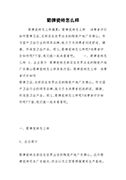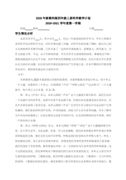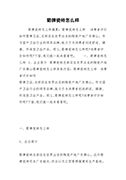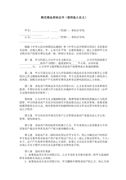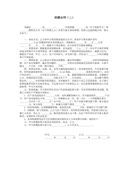《牛津小学英语》教案(精选12篇)六年级英语教案
《牛津小学英语》教案(精选12篇)
《牛津小学英语》教案 篇1
教学内容: 《牛津小学英语》4b第八单元第一课时
二、教学目标 :
1、 能听懂、会说,会读,会拼写单词a chair, a blackboard, a picture, a bookcase, a classroom, an office, a playground 。
2、 能听懂、会说,会读,会写句型 there's a / there are some ...in/ on/ near the ...
3、 熟悉歌曲 in the classroom 。
三、教学重点和难点:
1、 能听懂、会说,会读,会拼写单词a chair, a blackboard, a picture, a bookcase, a classroom, an office, a playground 。
2、 能听懂、会说,会读,会写句型 there's a / there are some ...
五、课前准备
教具准备 :
本课课件 及磁带录音机。
六、教学过程 step1. free talk:
1.师生用good morning/afternoon. how are you?互相问候。
2.出示课件,看图片复习学过的单词(食物类、水果类、职业类、家庭用品类)。
重点复习本课中的复现单词:a computer, a chair, a bookcase.
3.复习句型:let's go to the library. great! how do we go there? shall we go to thereby bus? ok. 练习"there" ,并书写。
4. let's sing the song 《the wheels on the bus 》,(出示课件音乐,并在每个地点类单词图片出现前播放)。
step2. presentation and practice
1、 出示library的图片。 t: look at my picture.
出示单词picture 并领读 s: 跟读. t:(指图片) what's this ? s: it's a library. t: what can you see in the library? s: i can see a picture , a computer and some bookcases.
2、出示课件歌曲《wheels on the bus 》 t:(出示office的图片)what's this ? s: …… t: it's an office .. 出示单词 office 示范朗读 s:跟读 t:what can you see in the office ? s: i can see a computer . t: so you can say: there is a computer. can you say like me? 出示句型:there is a/an …… can you say like me? s: there is a computer. there is a ... s:造句练习。
3、听音乐,做动作,出示classroom的图片 。 t: what's this ? s: it's a classroom . 出示单词 classroom 并领读 s:跟读 t: what can you see in the classroom?出示blackboard 的图片。 s: there's a blackboard . 学生造句练习…… t: 出示复数句型there are some …… s: (在教师帮助下 ) there are some desks . 学生学说并做造句练习。
4、同法教 a playground, a music room.
step3 a short break
1、enjoy a song 欣赏本课的歌曲 in the classroom
2、a game" magic ears” 游戏规则:教师说本课单词,不发出声音,仅让学生看口型,学生根据教师口型猜测是什么单词。
step 4. learn to say
1、在黑板上写出课题unit8 open day 并领读
2、出示本课单词图片。学生看图说单词。
3、t:(示范)this is an office. there is a/ an... on/ in the... there are some ...on/ in the ... can you say something like that? s:模仿教师练习句型。
step5 consolidation
1、看图说话比赛 ,练习书上part.c 教师出示书上图片。 学生分两大组比赛哪组说的多,说的好。 用句型: there is /are.... in / on the...
step 6 homework
1、听磁带,跟录音读对话。
2、单词抄写,各三遍。
附板书:
unit 8 open day
there is a /an……
there are some ……
《牛津小学英语》教案 篇2
一、教学内容
part a,b,c
二、教学目标
1.能熟练地听、说、读本单元所学单词、句型。
2.能初步将本单元句型运用到日常交际中。
3.能在教学活动中,感受到成功和快乐。
三、教学重点
1.能初步将本单元句型运用到交际中。
四、教学过程
step 1. greeting.
(日常问候语)
step 2. revision
1) free talk
师出示与本课内容相关的文具残缺图片若干,操练句型:
what’s this/that in english? 及其应答
2) 学习歌曲what is this in english?师示范后,学生跟唱。
3) 鼓励学生挑选喜欢的图片,小组创作新歌词,并集体演唱。
step 3. activity
1.i can draw a …跟着老师画文具类简笔画
2.listen and point.
3.listen and color.(师提供颜色,生自己涂色)
4.让学生将这些新文具摆放到合适的地方。建议:in the pencil box/desk/book; on the pencil box/desk/book等
5.师示范新对话,并让学生跟读。
如:
a: come here ,…
b:all right.
a: excuse me, what’s this on your book.
b: oh, it’s my tape.
look, it’s new.
it’s green and white.
it’s from my dad.
it’s on my book now.
6.学生以小组为单位,编新对话,并表演。
step 4. homework
1.将课上自己编的歌曲歌词以小报的形式展示出来。
2.口头向父母介绍自己的文具。
注意点:
1.活动课不能搭建花架子,所设计活动要紧紧围绕教学重点。
2.活动过程中要用语言,不仅用本单元,更要考虑到前面的知识联系。
活动资源要用足,用好。
《牛津小学英语》教案 篇3
一、教学内容
part a
二、教学目标
1. 能初步熟练地听、说、读上节课所学单词、句型。
2. 能听懂,会说,会读句子:
a) come here.
b) excuse me.
c) oh, i see.
3、能听、说、读、写单词bag, book ,tape
4、初步学会用英语有礼貌地询问物品的名称。
三、教学重点
1. 能正确朗读课文。
2. 能科学记忆四会单词。
四、教学过程
step 1. greeting.
t:good morning.
ss: good morning.
t: how are you?
…
step 2. revision
1) free talk
师示范: excuse me, what’s this/that in english?
it’s a …
领读excuse me。师生,生生间相互问答。
2)小诗复习单词
a crayon, a crayon.
it’s in the desk.
a knife, a knife.
it’s on the chair.
鼓励学生自己边摆文具,边创作小诗。
3) 完成教材e1听力练习。
4) look at these words carefully.
bag , cat , fat , dad
book , look , cook , hook
tape , name , kate
大声读完后,让学生试着总结后,集体背诵单词。
step 3. presentation
a: come here, …
b: all right.
a: excuse me, what’s this/that in/on the box?(利用遮盖等方式创设信息差,提高语言运用的真实性)
b: it’s a …
a: oh, i see. thank you.
b: that’s ok.
step 4. learning new materials
1. 领读新句子:come here,oh, i see.
2. 看课文插图,回答问题。
1) who are they?
2) where?
3) what color is the …?
3. 分两次听磁带,回答问题。
1) what’s that on the desk?
2) what’s this in english?
4. 跟读课文两遍。
5. 小组读课文。
6. 分角色朗读课文。
step 5. consolidation and practice
1. 鼓励学生看着课文插图,给图中人物配音。
2. 结合练习册内容,做适当练习。
step 6. homework.
1. 跟磁带大声朗读课文a,b五遍。
2. 抄写四会单词四遍,并背诵。
注意点:
1.课文朗读时间应尽量长一点,不能走过场,或寄希望于课后。
2.复习环节要方式多样化,扎实操练。
课文处理环节要注重教材资源利用。
《牛津小学英语》教案 篇4
一、教学内容
单元小练习
二、教学目标
1、 熟练掌握本单元的(三会、四会)单词、词组、句子及对话。
2、 运用已有语言知识解决问题。
3、 通过难度适中的适量小练习,帮助学生进一步了解自身学习状况,以促进以后的学习。
三、教学重点
引导学生学会发现本单元知识的薄弱环节,以便及时调整教学策略。
四、教学过程
step 1. greeting
sing an english song.( what is this in english?)
step 2. revision
1. 师提供本节课的话题“my stationery”,鼓励学生围绕此话题与教师或同学进行交谈。
2. 生齐读a、b部分,鼓励学生总结本单元学到的知识。
1) 一些文具类的单词,并初步接触了它们的复数形式。(knife是特例)
2) 会默写3个四会单词
3) 介词in/on, 借助这两个词语,我们可以表达物品的位置。让学生举例。
4) 初步掌握my/your/his/her +名词,表示某人的东西。
5) 用途很广的几个交际用语: come here. excuse me. oh, i see.
6) 询问物品的英文名称或中文名称时,我们可以用句子……
7) 询问近处或远处东西时,可以用句子……
3、完成小练习
小练习内容如下:
一、 请读一读下面的英语,你能写出对应的中文吗?
1. storybook_______ 2. copybook_______ 3. knife_______
4. toy train_______ 5.tape_______ 6.stapler_______
7. school bag_______ 8. in english_______ 9. in chinese_______
10. my pen_______ 11. your ruler_______ 12. his rubber_______
13. on the bookcase_______ 14. in the school bag_______
二、看图写单词
考察book, tape, bag.(可以适当增加1-2个与它们发音类似的单词)
三、模仿例子写复数
for example: a toy train------some toy trains
选择本课及以前学过的部分单词,其中可以设两个不规则的单词,数量控制在10个以内。
四、根据所给情境,从方框中选择合适的句子:
主要考察交际用语的掌握情况。
如:1. 需要打扰别人时,可以说:
2. 当你弄明白一件事情的时候,可以说:
3. 请某人过来,说:
4. 做错事情时说:
…
五、提供图片和句子,让学生给图中人物配上句子,并写出中文翻译。
建议: 对话控制在4句内,以本单元重点句型为训练重点。
注意点:
1. 让复习课不要成为老师的个人演讲。不要低估学生的三言两语,耐心的引导他们学会梳理知识,培养学习能力。
2. 练习内容的设计不同考试,目的重在单元基础,不可以难、偏、怪。学生通过练习可以客观的了解知识的掌握情况,老师也可以为下面的教学找准目标。
《牛津小学英语》教案 篇5
一、教学内容
part a,b,c,e2,e3
二、教学目标
1. 学会唱字母歌。
2. 能在熟练掌握本单元所学单词、句型基础上,巩固复习3a中文具类,动物类,交通工具类,食品类单词。
3. 能将本单元句型熟练地运用到日常交际中。
4. 能在教学活动中,感受到成功和快乐,增加学习英语的兴趣和自信。
三、教学重点
1. 能将本单元句型熟练运用到交际中。
四、教学过程
step 1. greeting.
learn to sing the song ”a b c” together.
step 2. revision
1) have a dictation
可以适当增加听音填字母的项目,促使学生尽快熟悉简单的读音规律,为记忆单词打下基础。
2)小组竞赛,说出文具类词语。
3) game. 模仿教材e2中形式进行。句型可以略作调整。what’s this in my school bag? it’s a …
规则:
1. 四人小组进行游戏。
2.摸物品,每人2次机会,答对的同学可以将物品放在自己的位置上。
3.最后物品最多的同学即是赢家。
4.若有同学用中文,失去一次猜谜机会。
step 3. consolidation and practice
1. t: you did a good job. i’d like to buy a toy for my nephew. would you like to go with me? guess, what can you see in the toy shop?
复习动物类,交通工具类,家具类词汇。
2. 情境一,示范对话,并让学生跟读。
a: hello, … how are you?
b: fine, thank you. and you?
a: i’m fine , too. let’s go to the toy shop by bus.
b: ok, let’s go.
a: here we are.
b: look, what’s that on the door?
a: it’s a …
b: oh, i see. come here, … what’s this on the desk?
a: it’s a …
b: how nice!
a: a …, please.
c: ok, here you are.
…
3. 小组合作,看图编对话。
4.情境二,买完玩具,一起去kfc吃了点东西。正巧遇到了一位外国人,相互自我介绍后,又相互请教了食品名称。
示范:(根据本班实际情况,选择是否继续示范)
a: hi, my name is … what’s your name?
b: my name is …i’m an english … i’m from …
nice to meet you.
a: nice to meet you, too. excuse me, what’s this in english?
b: it’s a packet of chips. what’s this in chinese?
a: han bao.
b: oh, i see. thank you.
5. 同桌模仿例子,编新对话。(师将提供的食品图片贴在黑板上)
step 4. homework
1. 跟磁带,大声朗读本单元课文五遍。
2. 提供图片及句子,请学生给句子排序,变成对话。
注意点:
1. 要在充分复习后,给学生创设表达的机会。
2. 情境创设要简洁,大情境中设置若干个小情境。
3. 运用前有示范。若学生情况好,可以逐渐放手。
《牛津小学英语》教案 篇6
一、教学内容
part b, c
二、教学目标
1. 能听懂,会说,会读单词:storybook, copybook, knife, toy train, tape, stapler, school bag, , in, on, in english
2. 能听懂,会说,会读句子:
a) what’s this/that in /on the …?
b) what’s this/that in english?及其应答句。
3、初步学会用英语询问物品的名称。
三、教学重点
1. 能正确朗读以下单词:knife, tape, stapler, crayon
2. 能正确区分this/that, in/on, tape/tap
四、教学过程
step 1. greeting.
t:happy new year to you all, boys and girls.
ss: the same to you.
t: how is your vacation?
s1: good.
s2: not so good.
…
step 2. revision
t: look, this is my …
it’s +color. how nice!
look, that’s his/her …
示范后,学生操练。
step 3. presentation
t:(指着课本)what’s this in english?
s1: it’s a book. (引导回答)
t: where?
s1: on the desk. (引导回答)
领读in english,on/in
示范后,生生利用身边的文具,操练新句型
step 4. learning new materials:
1. 将要学习的新单词实物放进袋子里,让学生随意挑选后,主动发问:what’s this/that in english?可求助老师,也可以求助同学。
2. 逐一板书新单词时,要求学生拼读。领读新单词,注重音节划分,单词构成,字母组合,新旧单词区分等方面的渗透。
如storybook, copybook ; crayon, day, bay ; knife ; toy train, boy ;tape , tap ; school bag ; sta pler
3. 游戏操练新单词。如高低声,看口形猜单词等。
4、利用图片或实物,操练单复数。a stapler? yes/no. some crayons? yes/no. …渗透复数概念,并强调knife---knives.
5.看b图说话。what can you see ? i can see a …
6.通过图片、实物、多媒体等方式创设情境,操练新句型:what’s this/that in/on the …?
step 5. consolidation and practice
1. 指导完成c部分的看图说话。
2. 条件允许的情况下,可将四段对话打印出来,让学生阅读后配对。
step 6. homework
1. 抄写b中词汇,每个两遍,中文一遍。
2. 跟磁带朗读b中词汇五遍,并拼读。
3.看图说话,自己操练c部分。
4. 准备一个自己感兴趣的物品,下节课带到课堂上。
注意点:
1. 教学内容较多,把握好时间分配,尤其是新授部分内容要予以充足的时间保证。
2. 新授单词,句子不要苛求每个学生都掌握得很熟练。
教学过程中要高频率,快节奏,充分激发学生的兴趣。
《牛津小学英语》教案 篇7
Unit 8 Open Day胡埭中心小学 王菁菁一、教学内容:《牛津小学英语》4B第八单元第一课时 二、教学目标 :1、 能听懂、会说,会读,会拼写单词a chair, a blackboard, a picture, a bookcase, a classroom, an office, a playground 。2、 能听懂、会说,会读,会写句型 There's a / There are some ...in/ on/ near the ... 3、 熟悉歌曲 In the classroom 。三、教学重点和难点: 1、 能听懂、会说,会读,会拼写单词a chair, a blackboard, a picture, a bookcase, a classroom, an office, a playground 。2、 能听懂、会说,会读,会写句型 There's a / There are some ...五、课前准备 教具准备 :本课课件 及磁带录音机。 六、教学过程 Step1. Free talk: 1.师生用Good morning/afternoon. How are you?互相问候。 2.出示课件,看图片复习学过的单词(食物类、水果类、职业类、家庭用品类)。重点复习本课中的复现单词:a computer, a chair, a bookcase. 3.复习句型:Let's go to the library. Great! How do we go there? Shall we go to there by bus? OK.练习"there" ,并书写。 4. Let's sing the song 《The wheels on the bus 》,(出示课件音乐,并在每个地点类单词图片出现前播放)。 Step2. Presentation and practice 1、 出示library的图片。 T: Look at my picture. 出示单词picture 并领读 S: 跟读. T:(指图片) What's this ? S: It's a library. T: What can you see in the library? S: I can see a picture , a computer and some bookcases. 2、出示课件歌曲《Wheels on the bus 》T:(出示office的图片)What's this ? S: ……T: It's an office .. 出示单词 office 示范朗读 S:跟读 T:What can you see in the office ? S: I can see a computer .T: So you can say: There is a computer. Can you say like me? 出示句型:There is a/an ……Can you say like me? S: There is a computer.There is a ... S:造句练习。 3、听音乐,做动作,出示classroom的图片 。T: What's this ? S: It's a classroom . 出示单词 classroom 并领读 S:跟读 T: What can you see in the classroom?出示blackboard 的图片。 S: There's a blackboard . 学生造句练习……T: 出示复数句型There are some …… S: (在教师帮助下 ) There are some desks . 学生学说并做造句练习。4、同法教 a playground, a music room. Step3 A short break 1、Enjoy a song 欣赏本课的歌曲 In the classroom 2、A game" Magic ears” 游戏规则:教师说本课单词,不发出声音,仅让学生看口型,学生根据教师口型猜测是什么单词。 Step 4. Learn to say 1、在黑板上写出课题Unit8 Open day 并领读 2、出示本课单词图片。学生看图说单词。 3、T:(示范)This is an office. There is a/ an... on/ in the... There are some ...on/ in the ... Can you say something like that? S:模仿教师练习句型。 Step5 Consolidation 1、看图说话比赛 ,练习书上Part.C教师出示书上图片。 学生分两大组比赛哪组说的多,说的好。 用句型: There is /are.... in / on the... Step 6 Homework 1、听磁带,跟录音读对话。 2、单词抄写,各三遍。 附板书: Unit 8 Open Day There is a /an…… There are some ……
《牛津小学英语》教案 篇8
unit 3 asking the way
连云港市赣榆县实验小学 董淑鸿
单元教材分析:
本单元的核心教学内容是“问路”,围绕这一话题展开各项语言活动。重点学习问路中常涉及的相关用语can you tell me the way to…?how far is it from here? how can i get to…?及其答语。本单元a部分通过创设情景,展开一段有关问路的情景对话;b部分主要学习表示场所的词组以及与问路相关的动词词组;c部分和d部分是本单元的句型结构部分,重点学习句型及其答句。要求学生能够四会掌握这些句型;e部分重点复习了本单元的重点句型turn…at the…crossing和一般过去时;f部分是一个趣味猜迷游戏,可以让学生在听听、看看、做做、玩玩中活动;g部分为语音部分,让学生了解字母组合ou在单词中的读音,提高整体认读能力;h部分是一首歌曲,可以联系本课内容进行填词唱歌。
教学目标:
1、能听懂、会说、会读和会拼写单词stop, turn left / right, post office, get on / off, along, street, way。
2、能听懂、会说、会读单词city, crossing, away, follow, suddenly, shout, thief, shopping centre, middle school, primary school, out of, train station, story museum, kilometre, road, minute, only。
3、能听懂、会说、会读、会写句型:can you tell me the way to…,please?
4、能听懂、会说、会读日常交际用语和句型go along this street, and then turn right at the third crossing. how far is it from here? it’s about a kilometre away. you can take bus no.5. how many stops are there? how can i get to the shopping centre?
5、了解字母组合ou在单词中的读音。
6、能演唱歌曲excuse me。
教学重点:
1、能听懂、会说、会读和会拼写单词stop, turn left / right, post office, get on / off, along, street, way。
2、能听懂、会说、会读、会写句型:can you tell me the way to…,please?
教学难点:
1、能听懂、会说、会读和会拼写单词stop, turn left / right, post office, get on / off, along, street, way。
2、能听懂、会说、会读、会写句型:can you tell me the way to…,please?
教具准备:
本单元的单词卡片、挂图、磁带、录音机、自制城市地图。
课时安排:共6课时
第一课时:b look, read and learn及 c look and say
第二课时:b look, read and learn及 d read and talk
第三课时:a listen, read and say
第四课时:e read and number及f play a game
第五课时:g listen and repeat及h sing a song
第六课时:复习并完成补充习题。
友情提示:
1、本单元主要围绕“问路”这一话题开展各项语言活动。在操练中要尽量为学生创设真实的情景,充分利用图片、交通图、多媒体等直观手段引导学生学习,还可以将教学内容生活化,利用学校周围的场所或学生感兴趣的景点进行扩展练习,真正达到学以致用的目的。
2、本课a部分的内容很长,生词和交际用语也非常多,学生在学习中有一定难度。教学的程序可以适当调整为:第一课时b、c结合,学习本单元的词汇和主要句型;第二课时把b、d结合,在学习日常交际用语的同时进一步巩固b部分的词汇;第三课时再回过头来学习a部分,有了前两课时的铺垫和渗透,a部分的对话教学就容易多了,学生在理解上就不会有太大困难。
3、在句型教学中,采用chant的方法可以激发学生的学习热情,使枯燥的对话练习富有生机,同时分解了知识的难点,提高了学习效率。
4、设计活动时要注重新旧知识的滚动训练,提高学生的实际运用能力。
《牛津小学英语》教案 篇9
一、教学内容
《牛津小学英语》2a unit7 here you are第一课时。
二、教学目标
a) 知识与技能目标:
1.能听、说、读有关食品类单词a pie ,a cake, a hamburger, a hot dog。
2.能初步运用句型…,please.
b) 情感目标:
1.通过直观有效的教学方法,激发学生的学习兴趣,集中学生的注意力,提高学习效率。
2.通过学习,让学生更好地了解食品,养成不浪费的好习惯。
三、教学重、难点
a) 使学生能够理解并熟练掌握单词a pie,a cake,a hamburger和 a hot dog。
b) 初步运用句型…,please.
四、教学准备
生词卡、课件、练习题
五、教学过程
step 1 warming up
a) greetings
b) free talk
(1)t: what’s this?
s: it’s a pencil box/ rubber/ ruler.
t: look at the…
s: oh, it’s…
(2)t: what are these/ those?
s: they are carrots/ potatoes…
step 2 presentation
1.复习课堂用语(教师发出命令,学生边说边做动作)
stand up!
sit down!
open your book.
close your book.
touch your nose.
…
t: how are you?
s1:i’m fine, thank you.
t: how are you?
s2:i’m fine, thank you. and you?
t: oh, i’m not so good. i’m tired and feel a little hungry now. i want to go to the snake bar. let’s go together. ok?
ss: ok!
(出示课题)
3.教师拿出一个托盘,托盘里放着四个一模一样的盒子, 盒子里分别放着四种将要学习的单词(a pie、 a cake、 a hamburger、 a hot dog)
(1)t: look. what’s this?
it’s a pie.
learn: a pie(采用分组读,男、女声比赛读等方法操练单词。)
chant: a pie, a pie , i like pies.
(2)t: (教师又拿出一个里面放着蛋糕的盒子,请一名学生尝一尝并猜一猜)
is this a pie?
s:no, it isn’t.
learn: a cake(运用小组比赛读、看手势读等方法练习单词)
chant: a cake , a cake , i like cakes.
(3)t: what’s this in the box? who can smell and guess it? (教师再次拿出一个盒子,里面放着一个汉堡包,请一名学生闻一闻并猜一猜)
learn: a hamburger(运用小组读、看手势读等方法读单词 )
chant: a hamburger 、a hamburger,i like hamburgers.
(4)t: anything else? who can touch it and guess it what’s this in the box?(教师拿出最后一个盒子,让学生摸一摸、猜一猜)
learn: a hot dog(采用分组读,男、女声比赛读等方法操练单词。)
chant: a hot dog 、a hot dog,i like hot dogs.
4. play a game
what’s missing?
step 3 consolidation
活动手册p25
1、观察每组图中的物体,请学生说一说;
2、解释做题要求,请学生听句子答题。
step 4 homework
听录音,跟读b部分生词。
《牛津小学英语》教案 篇10
教学内容:a listen, read and say
教学目的:
1.能听懂、会说、会读单词词组:minute, twin, child、 also, chat.
2.能听懂、会说和会读日常交际用语i’m as tall as you. su yang’s (twenty minutes) younger than su hai.
3.能听懂、会说、会读、会写句型who’s taller than david? gao shan is taller than david.
教学重点:
1.能正确、规范地朗读课文,理解课文内容。
2.掌握句型“who’s…than…?”。
教学难点:
1.流利、规范朗读课文。
2.灵活运用句型:“…than…”与情景中。
教学过程:
step1 warm up
1. listen to a song: i wish i was taller
2. greetings
3. free talk
利用室为现有物品围绕上节课所学句型与生交谈.如:hello, is this your ruler? where’s her/his ruler? whose ruler is longer, yours or hers/ his? how old are you? who’s younger/older than you? do you know. who’s fat/thin? who’s taller/shorter than…? look, ××is as tall as…(此句重在引导生理解as…as句式为本课学习新型做铺垫)…
step3 presentation
1.学习引言部分
①listen to the tape and answer the questions.
a. on sunday morning, who went for a walk in the park?
b. who did she meet?
c. what did she do?
②根据回答随机出示并学习词组“go for a walk have a chat, meet-met”
③listen to the tape and repeat.
④read together.
2.学习twin, look the same, twenty minutes, one day.
①出示su hai和su yang的图片谈话形式引出“twin, look the same, twenty minutes”如:t: look at the picture. who are they?
s: they’re su hai and su yang?
t: yes. they’re twins.(出示单词)they look the same.(出示词组)do you know. who’s younger?
su yang is twenty mantes younger than su hai(出示词组twenty minutes)do you want to meet them one day?(出示“one day”)
②指导朗读出示的词组。
3.listen to the tape and answer questions.
①do su hai and su yang look the same?
②is su hai as tall as su yang?
③who’s younger, su hai or su yang?
④does jack has any brothers or sisters?
⑤who’s jimmy?
⑥how old is jimmy? who’s younger, jimmy or jack?
step4 consolidation
1. listen to the tape and repeat.(出示本部分挂图,生边听边观察图)
2. read after the tape.
3.完成课后填空题。①生自由填空 ②check and read
step 5 homework
1. listen and read the text.
2.根据家庭照片模仿课文内容,自编对话。
板书内容:
词组:go for a walk, have a chat, twin, minute, as…as, meet-met
句子:a: are you as tall as your twin sister? b: no, i’m taller than su yang.
a: who’s younger, you or su yang?
b: su yang’s twenty minutes younger than me?
板书设计:
教后笔记:
《牛津小学英语》教案 篇11
教学内容:d. listen and write e. read, think and write
f. think and write
教学目标:
1、能听懂,会说和会读单词finish。
2、向学生介绍英文书信的书写方法,渗透跨文化交际的意识和能力。
3、大体了解e-mail与书信的不同之处。
教学重难点:
1、培养学生良好的听力习惯,提高听力水平。
2、搞清中西方书信的不同写法。
教具准备:磁带、挂图、小黑板
教学过程:
step 1 warm up
1、greeting
2、listen a rhyme: i want to write a letter.
3、duty report
请几位学生上台进行自我介绍。
4. revision
①默写单词:also, a penfriend, glue, write a letter.
②开火车朗读对话。 ③男、女生分角色背诵对话。
④小组合作表演对话。
step 2 presentation
1. listen and write
本部分为一段有关helen在笔友俱乐部征集笔友的对话,要求学生通过听录音完成填表练习。
①在学生听录音前,教师可先引导他们看练习的引言部分,简单介绍对话背景,让他们了解对话主题(at the penfriend club),预测可能听到的内容,做好心理准备。
②教师可播放全文录音,鼓励学生逐步养成整体接受语言材料的习惯。
③根据表格内容师生、生生间采用一问一答形式进行操练。
④指导学生完成填表练习。
⑤教师与学生共同讨论练习答案,并分析错误原因,找到解决方法。
2.read, think and write.
本部分展示了liu tao写给peter的信,要求学生在阅读来信的基础上帮助peter给liu tao回信,重点训练了学生的阅读理解能力和写作能力。
①教师先引导学生自己阅读本课的语言材料,理解句子含义。读时本部分出现的生词,教师可采取不同的处理方法:可在阅读前讲解,也可启发学生通过上下文猜测。如单词finish就可以联系上下文猜测。
②引导学生分组讨论liu tao 的来信和peter的回信,通过问答,如询问“how old is liu tao?”、“where does he live?”、“does he have any brothers or sisters?”等问题让学生理解信中内容。
③让学生仔细观察并自己总结信件的格式、写法,包括地址,日期,起首语,结尾问候语的处理方法,注意提醒学生英文书信中的地址书写要从小到大。
3. think and write
本部分是peter给liu tao的回信,介绍除书信以外的另一种通讯方法e-mail,或称电子邮件。
①通过问答如who’s peter? where does he live?等让学生回忆起a部分的一些资料。
②让学生仔细阅读f部分有关peter的资料,让学生加深对peter的了解。
③教师介绍书信以外的一种通讯方法-e-mail。可询问学生是否有用电子邮件的习惯,鼓励学生说出新通讯方式的好处与坏处。
④让学生观察书中e-mail的格式,引导他们说出与书信的不同之处。
⑤请学生两人一组完成填空练习。
⑥集体订正。 ⑦集体朗读一遍,分组朗读一遍。
step 3 homework
1、朗读e、f部分各一遍。
2、熟练背诵a部分对话,并自创对话。
3、模仿e部分,用英语给同学或老师写一封信。
板书内容:
1、课题:unit 7 a letter to a penfriend 2、单词:finish
板书设计:
《牛津小学英语》教案 篇12
教学内容:a. listen, read and say(第一、二部分)
教学目标:
1、能听懂、会说、会读并会拼写单词penfriend, also。
2、能听懂、会说、会读i want to write a letter. who do you want to write to?
3、正确理解、掌握对话内容,并能朗读,表演对话。
教学重难点:正确理解,掌握对话内容,并能朗读,表演对话。
教具准备:几封信,a部分教学挂图,小黑板。
教学过程:
step 1 warm up
1、greeting.
2、revision.
①出示单词卡片,开火车读,遇到四会单词要拼写。
②学生间自由操练c部分句型。
教师可与一学生问答引出,再由学生进行操练。
③教师现场说一物品,两位学生合作,如:writing paper,请学生快速按照c部分句型编对话。
for example:
a: can i have some writing paper? b: what for?
a: i want to write a letter. b: sure. here you are.
step 2 presentation
1、因为对话较长,再将a部分分为三部分教学:第一部分为引言部分,第二部分为liu tao向妈妈要一些写信材料,准备写信,第三部分为liu tao向妈妈介绍peter的主要情况,并和妈妈讨论回信内容。
2、listen to the tape.
3、teach: a penfriend.
①教师出示自己收到的一封信,告诉学生look! here’s a letter from my penfriend,引出单词a penfriend.
②教师范读,讲解词义,告诉学生penfriend是合成词,由单词pen和单词friend组成,pen和friend都是以前学过的单词,pen-friend→penfriend。
③学生齐读a penfriend。 ④开火车拼读penfriend。
a. pen, pen, p-e-n, pen, pen.
b. friend, friend, f-r-i-e-n-d, friend, friend.
c. penfriend, penfriend, p-e-n-f-r-i-e-n-d, penfriend, penfriend.
4、 teach: also b. friend, friend,
①教师出示教学挂图,告诉学生liu tao also wants a penfriend。
②出示单词卡片also,解释词义。 ③学生分组读also。
④集体拼读also, also, a-l-s-o, also, also。
5、教师用语音直接导入yesterday afternoon, liu tao read about an english boy, peter, in the newspaper. what does liu tao want to do? let’s listen.教师组织学生听引言部分录音。
6、听完录音后,请学生回答问题,引导学生看图学习课文。
question: ①who did liu tao read about yesterday afternoon?
②what did peter want in china? ③what would liu tao like to do?
7、对话第二部分是c部分已学过的句型,可采用巩固的方式引出新内容。
教师课前将此部分的句子打乱顺序写在卡片上,现将卡片贴于黑板上,请学生四人为一组,共同讨论,看哪一组学生可以最先排列好顺序,并猜该组成员,每人教读一句。
for example:
( ) thank you.
( ) i want to write a letter.
( ) sure. here you are.
( ) what for, dear?
( ) mum, can i have some writing paper, an envelope and some stamps, please?
step 3 consolidation
1、听录音,跟读引言和对话部分。 2、师生齐读引言和对话一遍。
3、分角色朗读。 4、小组内表演对话。
5、指名表演对话。
step 4 homework
1、听a部分录音半小时,跟读两遍。 2、抄写a penfriend, also各五遍。
3、预习第二部分,请学生自编问题,下节课准备同学间交流。
板书内容:
1、课题:unit 7 a letter to a pen rend 2、单词:a penfriend, also
板书设计:


